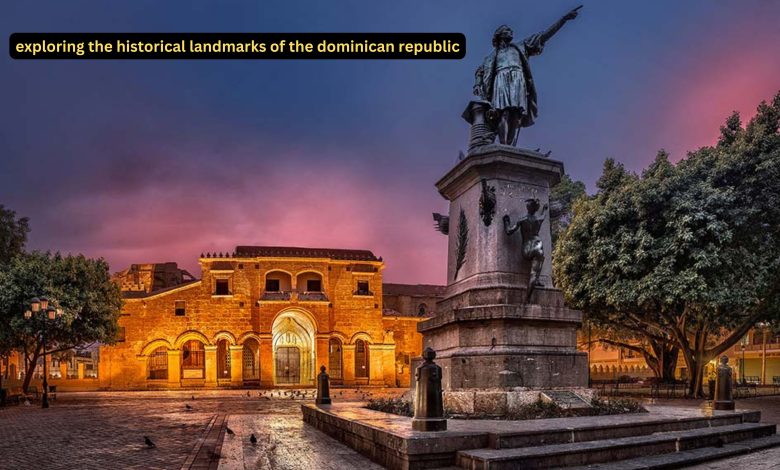Exploring the Historical Landmarks of the Dominican Republic

The Dominican Republic, a Caribbean nation with a rich tapestry of history, offers travelers a journey through time with its numerous historical landmarks. From the cobblestone streets of the Colonial Zone in Santo Domingo to the ancient ruins of La Isabela, these sites reveal the stories of conquest, colonization, and cultural fusion. This article delves into the most significant historical landmarks that every history enthusiast should explore when visiting the Dominican Republic. Also, you can read the Dominican Republic travel guide here:
https://offvisa.com/fr/news/exploring-dominican-republic-essential-travel-information
The Colonial Zone in Santo Domingo
The Colonial Zone, or Zona Colonial, in Santo Domingo is a UNESCO World Heritage site and the oldest continuously inhabited European settlement in the Americas. Founded by Christopher Columbus’s brother, Bartholomew Columbus, in 1498, this area is a treasure trove of historical significance. Visitors can walk along Calle Las Damas, the oldest paved street in the New World, and explore landmarks such as the Alcázar de Colón, the former residence of Diego Columbus, Christopher’s son. The Gothic-style Catedral Primada de América, the first cathedral in the Americas, stands as a testament to the architectural prowess of the Spanish colonizers.
The Ruins of La Isabela
La Isabela, located on the north coast of the Dominican Republic, holds the distinction of being the first European town in the Americas. Established by Christopher Columbus during his second voyage in 1493, La Isabela was intended to be a permanent settlement. Today, visitors can explore the ruins of this historic site, including the remains of Columbus’s house, the church, and various other structures. The site provides a fascinating glimpse into the early attempts at colonization and the struggles faced by the settlers, including conflicts with the indigenous Taíno people and challenges from the harsh environment.
Fortaleza Ozama
Fortaleza Ozama, a prominent feature of the Colonial Zone, is the oldest fortress in the Americas. Constructed between 1502 and 1508, this fortress was strategically built to protect Santo Domingo from potential sea attacks. The fortress has witnessed numerous historical events, including pirate invasions and colonial battles. Visitors can tour the well-preserved structure, climb the towers for panoramic views of the Ozama River and the surrounding city, and learn about its storied past through informative displays and guides.
Altos de Chavón
While not ancient, Altos de Chavón is a meticulously crafted replica of a 16th-century Mediterranean village, blending history with art and culture. Located near La Romana, this cultural center was built in the 1970s and has become a hub for artists and tourists alike. The village features cobblestone streets, charming stone buildings, and an amphitheater that hosts various cultural events. The Regional Museum of Archaeology within Altos de Chavón showcases artifacts from the island’s pre-Columbian era, providing insights into the lives of the indigenous Taíno people before the arrival of the Europeans.
The Three Eyes National Park (Los Tres Ojos)
Los Tres Ojos National Park, located in Santo Domingo, offers a unique historical and natural experience. This park is home to a series of underground caves and freshwater lagoons, known as “the three eyes” due to their unique appearance. The caves were used by the Taíno people for religious ceremonies and daily activities. Visitors can explore these stunning natural formations, learn about the geological history, and understand the cultural significance of these caves to the indigenous populations.
The Ruins of San Francisco
Another significant landmark in the Colonial Zone is the Ruins of San Francisco, the remains of a Franciscan monastery built in the early 16th century. This structure, one of the first monasteries in the New World, has witnessed earthquakes, pirate attacks, and the passage of centuries. Despite its dilapidated state, the ruins exude a sense of historical grandeur and are often used as a venue for cultural events and concerts, adding a modern layer to its historical significance.
Planning Your Visit
The eTicket for the Dominican Republic is a mandatory travel requirement for all visitors, including citizens of the country, and is necessary for both entry and exit by air. The eTicket can be easily and accurately completed online through the Offvisa service. It consolidates the entry and exit card, travel health affidavit, and customs declaration into a single digital form. For visa-exempt nationalities, the eTicket allows a stay of up to 90 days in the Dominican Republic. It’s important to remember that the eTicket does not replace the need for a visa. If your nationality requires a visa, you must obtain both a visa and an eTicket, and present both documents upon arrival at immigration. Learn more: https://offvisa.com/fr/visa-for-Dominican-Republic-fr
Conclusion
The Dominican Republic is a land where history comes alive through its well-preserved landmarks and ruins. From the bustling streets of Santo Domingo’s Colonial Zone to the tranquil, evocative ruins of La Isabela, each site offers a unique window into the past. Whether you are an avid historian or a casual traveler, exploring these historical landmarks will enrich your understanding of the Dominican Republic’s complex and fascinating history. Plan your visit to these remarkable sites and step back in time to witness the events that shaped this vibrant Caribbean nation.